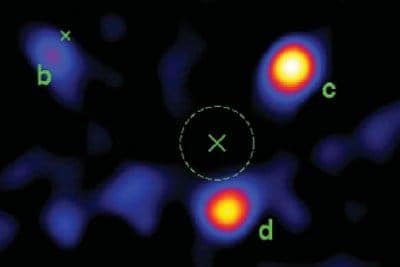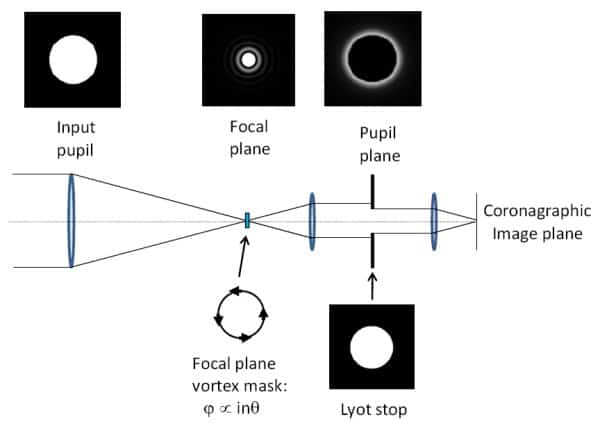
Astronomers in the US have invented a new technique to take direct images of planets orbiting distant stars. The breakthrough means that it should now be feasible to see such “exoplanets” with much smaller telescopes than is currently possible. Although the technique has not yet been used to find any new expolanets, the researchers have confirmed the existence of three known planets orbiting a distant star.
The first planet orbiting another star was found in 1995 and since then astronomers have gone on to discover more than 450 such bodies. Most exoplanets have been detected indirectly by observing their effect on the brightness or motion of their parent stars.
However, the best way of determining the chemical composition of an exoplanet, which could tell us whether it harbours life, is to analyse the spectrum of light travelling directly from the exoplanet to Earth. The problem is that direct detection is very difficult using smaller ground-based telescopes. So far direct images have only been possible with the Hubble Space Telescope and several very large ground-based telescopes.
Size matters
Now, however, Gene Serabyn and colleagues at Jet Propulsion Laboratory near Los Angeles have come up with a way of imaging exoplanets using much smaller telescopes. Indeed, their measurement with a 1.5 m diameter instrument is as good as that from a much larger, 10 m telescope.
Serabyn’s team began by sharpening an image of a star using adaptive optics to remove most of the distortion that occurs when starlight passes through the Earth’s atmosphere. The resulting image consists of a diffraction pattern comprising a bright central disc surrounded by concentric dark and bright circles – an unavoidable consequence of light passing through the aperture of the telescope.
The problem is that if the star has an exoplanet, its image will be much fainter and can be obscured by this diffraction pattern. Indeed, astronomers are only able to resolve exoplanets orbiting beyond a certain distance from the star because the brightness of the pattern decreases rapidly from the central maximum. This distance is inversely proportional to the size of the telescope’s aperture, which is why larger instruments have to be used.
Diffraction free
Serabyn and colleagues got around this problem by using a “vortex coronagraph”, which blocks out the light from a star and removes much of the diffraction pattern from the image. Pioneered by team-member Dimitri Mawet and others, the vortex coronagraph is a small glass “phase plate” that applies a spiral phase-shift to light passing through it. The starlight is focused at the very centre of the plate, meaning that the starlight emerges from the other side at a relatively large angle with respect to the axis of the telescope (see diagram).
But because the exoplanet is at a different position than the star, its light is not focused at the very centre of the plate and so emerges at a much smaller angle. The starlight is then removed using a blocker with a central hole, through which the light from the exoplanet can pass.
The team tested their scheme using the 5.1 m diameter Hale telescope on Palomar Mountain in California. Instead of using all the light gathered by the telescope, the team used a reduced aperture of 1.5 m because this allowed the adaptive-optics system to deliver the best possible image.
The team aimed the telescope towards the star HR 8799, which is known to have three exoplanets that had been imaged directly in 2008 by Christian Marois and colleagues at the Herzberg Institute of Astrophysics in Canada. Marois used a 10 m telescope at the Keck observatory in Hawaii and was able to see to within 440 milliarcseconds of the star.
Using their 1.5 m setup, Serabyn and colleagues could also see all three exoplanets – and had a clear view to within 300 milliarcseconds of the star. Marois, who was not involved in the Palomar observation, described the result as “remarkable”, adding that “we can expect great discoveries to be made when we’ll have a similar optimal setup working on the full 8–10 m aperture in the next few years”.
More telescopes
One advantage of the technique is that it could allow many more telescopes to obtain direct images of exoplanets. Indeed, Serabyn believes that it could be used to enhance 50–100 existing instruments. In addition, space telescopes designed to find exoplanets could be made smaller and hence cheaper and easier to deploy.
“Our goal is to someday take snapshots of solar systems, showing all of the planets in their orbits around the star, and to do spectroscopy on all of them,” Serabyn told physicsworld.com. He adds that the team is also talking to several groups developing next-generation adaptive optics about integrating vortex coronagraphs.
The team will return to Palomar this summer, where it will carry out a survey of nearby stars in search of exoplanets.
The work is described in Nature 464 1018.




